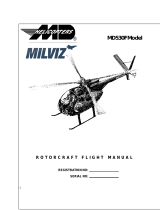190-01150-12 Rev. E RFMS Garmin G500H as installed in Bell 206A
Page 4 of 33 FAA APPROVED
Table of Contents
SECTION 1. OPERATING LIMITATIONS .................................................. 6
1.1 TYPES OF OPERATION ........................................................................... 6
1.2 SYSTEM SOFTWARE REQUIREMENTS ..................................................... 6
1.3 EQUIPMENT REQUIREMENTS ................................................................. 6
1.4 AHRS OPERATIONAL AREA .................................................................. 7
1.5 AHRS OPERATION ................................................................................ 7
1.6 AIRSPEED LIMITATIONS AND INDICATOR MARKINGS ............................ 7
1.7 NAVIGATION ANGLE ............................................................................. 7
1.8 HELICOPTER SYNTHETIC VISION TECHNOLOGY (HSVT) ...................... 7
1.9 TERRAIN AND OBSTACLE DISPLAY........................................................ 8
1.10 MOVING MAP ........................................................................................ 8
1.11 DATALINKED WEATHER DISPLAY (XM, GFDS, FIS-B WEATHER) ........ 8
1.12 TRAFFIC DISPLAY .................................................................................. 8
1.13 SURFACE OPERATIONS .......................................................................... 9
1.14 MFD VIDEO DISPLAY ........................................................................... 9
SECTION 2. OPERATING PROCEDURES ................................................ 10
2.1 NORMAL PROCEDURES ................................................................ 10
2.1.1 PFD Knob & PFD Soft Keys ...................................................... 10
2.1.2 MFD Knobs & MFD Soft Keys................................................... 11
2.1.3 Helicopter Synthetic Vision Technology (HSVT) ....................... 11
2.1.4 HSVT Terrain ............................................................................. 11
2.1.5 ALTITUDE Alerter ..................................................................... 11
2.1.6 EDO VNAV................................................................................. 11
2.2 EMERGENCY PROCEDURES ........................................................ 12
2.2.1 Loss of Electrical Power ............................................................ 12
2.2.2 Primary Flight Display .............................................................. 12
2.2.3 AHRS Failure ............................................................................. 12
2.2.4 Heading Failure ......................................................................... 12
2.2.5 Air Data Computer (ADC) Failure ............................................ 13
2.2.6 GPS Data Failure ...................................................................... 14
2.2.7 Navigation Data Failure (VOR/LOC/GS/ADF) ......................... 14
2.2.8 Synthetic Vision .......................................................................... 14
2.2.9 Display Dimming ....................................................................... 15
2.2.10 Warnings, Cautions, and Advisory Annunciations ..................... 15
SECTION 3. PERFORMANCE DATA ......................................................... 18
GENERAL INFORMATION ......................................................................... 19
GARMIN G500H FLIGHT DISPLAY SYSTEM ..................................................... 19
SYSTEM POWER SOURCES............................................................................... 21
























